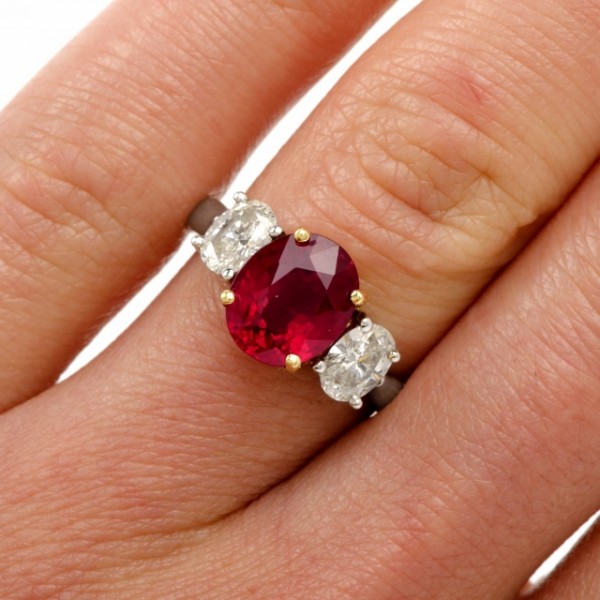
Ruby is the magnificent red variety of the multi-colored corundum family of which sapphire is also a member. Pure corundum is colorless, but elements such as iron, chrome, titanium or vanadium produce the mineral’s intriguing colors. The main element inherent in the structure of ruby is chrome, which is both the coloring ingredient and paradoxically also responsible for the scarcity of ruby!
Bond Street Invades Valuable Corner of Burma
The Town of Mogok in Upper Burma was for centuries the birthplace of the finest rubies in the world, but it was not until the British annexed the region in the late 19th century that the deposits could be mined effectively under the auspices of Edwin Streeter, a renowned Bond Street Jeweler. The number of gem quality stones over 5 carats that emerged during the period of British ownership was relatively small, and further mining virtually ceased since the British departed shortly before the Second World War.
Internally Illuminated Pigeon Blood
The highly prized rubies from Burma are mainly colored by chromium giving them the distinctive blood-red hue, from which derives the term ‘pigeon blood’ color, describing the most sought-after and valuable stones. The presence of chromium as the sole coloring agent in the gemstone often gives rise to a strong fluorescence. In the case of Burmese rubies, this fluorescence exhibits itself even in artificial light which results in the appearance of internal illumination.
King of Gemstones: Color Before Clarity <(/b>
The most important feature of rubies is their color, rendering transparency of secondary importance in determining their value. Inclusions do not impair the quality of rubies, provided they do not decrease the transparency of the stone, nor if they are located in the stone’s center. In fact inclusions within a ruby could be its ‘fingerprint’, i.e. a statement if its individuality, advertising its natural origin.Only a perfect cut can emphasize the beauty of this precious stone in a manner worthy of its Sanskrit name ‘the king of gemstones’…
Astrological Concepts: Stars Silk Rutile & Asterism.
Experts refer to the ‘silk’ of a ruby when describing the wonderful silky shine of the red corundum. This phenomenon is due to extremely fine needles of rutiles, a mineral which forms a star-shaped deposit within the ruby and causes a captivating light effect technically referred to as ‘asterism’.
What is a ‘star Ruby’? <(b)>
If rubies with rutile are cut in semi-domed cabochons, the result would be a six-point star, which seems to glide magically across the surface of the stone when the latter is moved. Star rubies are very precious rarities. While their value is dependent upon the beauty anf attractiveness of their color, the nature and position of the rays whtin the stone is also an influential factor.
The most valuable star-rubies display fully formed rays along an imaginary line dissecting the stone, as it were, while the star itself is situated at the very center of the ruby.
Rubies on Peacock Features: Ancient Method of Mounting Rubies…
Historically, rubies were mounted above a peacock feather, specifically the blue quills. This ancient mounting method was a precursor to ‘foil-backing’
of colored gems and was done to give a shimmering brilliance to this highly sought-after gem, color derived from the iridescent feathers. Early ‘foil-backing ‘ was used for settin g colored stones throughout the Georgian era, extending to mid-Victorian times, adding shen and luster to the traditional cutting skills that shaped the gem world of such times.
Steeped in Historical & Mythological Legends
Ruby, the July birthstone, is one of the most precious gems., cherished and endowed with innumerable attributes in many cultures. To the Greeks, rubies were thought to be the ‘living coal’, as though red hot coals were converted into these desirable stones…
According to Hebrew legends, rubies became symbolic of the boy Reuben whose conduct vis-a-vis his father made him brush! Ruby was also one of the 12 gems which made up the sacred Ephod of the Hebrews… The ancient Burmese believed that rubies gradually ripened in color. while maturing in the earth, as fruits would ripen on a tree over the course of time.
Rubies for Health, Wealth, Wisdom & Love….
Ancient rubies were generally made into amulets by ancient peoples to guard against poisons, plague, evil thoughts, and wicked spirits.
Famous Historical Rubies in Museums…
Amongst the rubies noted historically is a huge stone handed to England’s King William III in 1d697 by young Peter the Great of Russia, while he was learning ship-building in England.
The world’s museums display notable rubies including ‘Edward’s Ruby’ weighing 167 cts, safely displayed in the Natural History Museum in London. At the American Museum of Natural History in New York is the ‘Edith Haggin de Long Star Ruby which is a magnificent 100ct gem, and Washington’s Smithsonian Institute displays the 137ct. Rassar Reeves Ruby…
.


